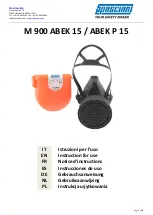
Ridge Tool Company
12
Scout™ Sonde and Line Locator
Operating Tips for Locating a Sonde
• Use the sound when possible to help guide the Scout
to the maximum signal strength.
• If the Equator is crossed, and the signal is not maxi-
mized, follow the Equator to the highest signal strength.
Simply finding the Equator of the sonde (the dashed
line on the screen) does
NOT
indicate that the sonde
has been found.
The point of maximum signal
strength
along this line must
also
be found. Generally
following the Equator line will lead the operator to the
“vicinity” of the sonde. If the sonde is steeply tilted, the
Equator will NOT lie directly above the sonde and the
distance from the sonde to each Pole will not be equal.
If the sonde is tilted, maximize the signal.
• Always confirm the point of maximum signal strength.
Verify what the map is showing. The map assumes the
following conditions:
1.The ground is level
2.The sonde is level
3.The Scout Locator is above ground level
4.The Scout Locator is held approximately vertical, an-
tenna mast pointing straight down.
If these conditions are not met, pay close attention to
maximizing signal strength. In general, if the above con-
ditions are true and if the Scout is within about two
“depths” of the signal source, the map will be useful
and accurate. Be aware of this when using the map if the
target or signal source, is very shallow. The useful
search area using the map alone can be small if the
sonde is extremely shallow.
Figure 25
2. Depth will be shown in the lower left hand corner.
3.
Force Depth Feature
– If the angle indicator reads
higher than 5 degrees then the Scout will not give a
depth measurement. Press the down arrow key and
hold it. This will force the depth to display if depth can
be measured.
(See the following section on tilted
sondes.)
The bubble level is useful when measuring depth to
make sure that the antenna mast is vertical.
In order to maximize signal and achieve a more ac-
curate depth reading, the Scout needs to be rotated to
align the upper antenna with the signal.
Using the force depth feature can pro-
vide inaccurate depth measurements.
When checking the depth
always
take a measurement,
then rotate the Scout 180 degrees (
1
/
2
circle) and take an-
other depth measurement. Be sure that the lower ball
stays at the same position on the ground and the mast is
vertical.
If the depth readings are not within about
10% of each other then distortion is present and the
depth reading should be questioned.
WARNING
Figure 26
www.
GlobalTestSupply
.com
Find Quality Products Online at:















































